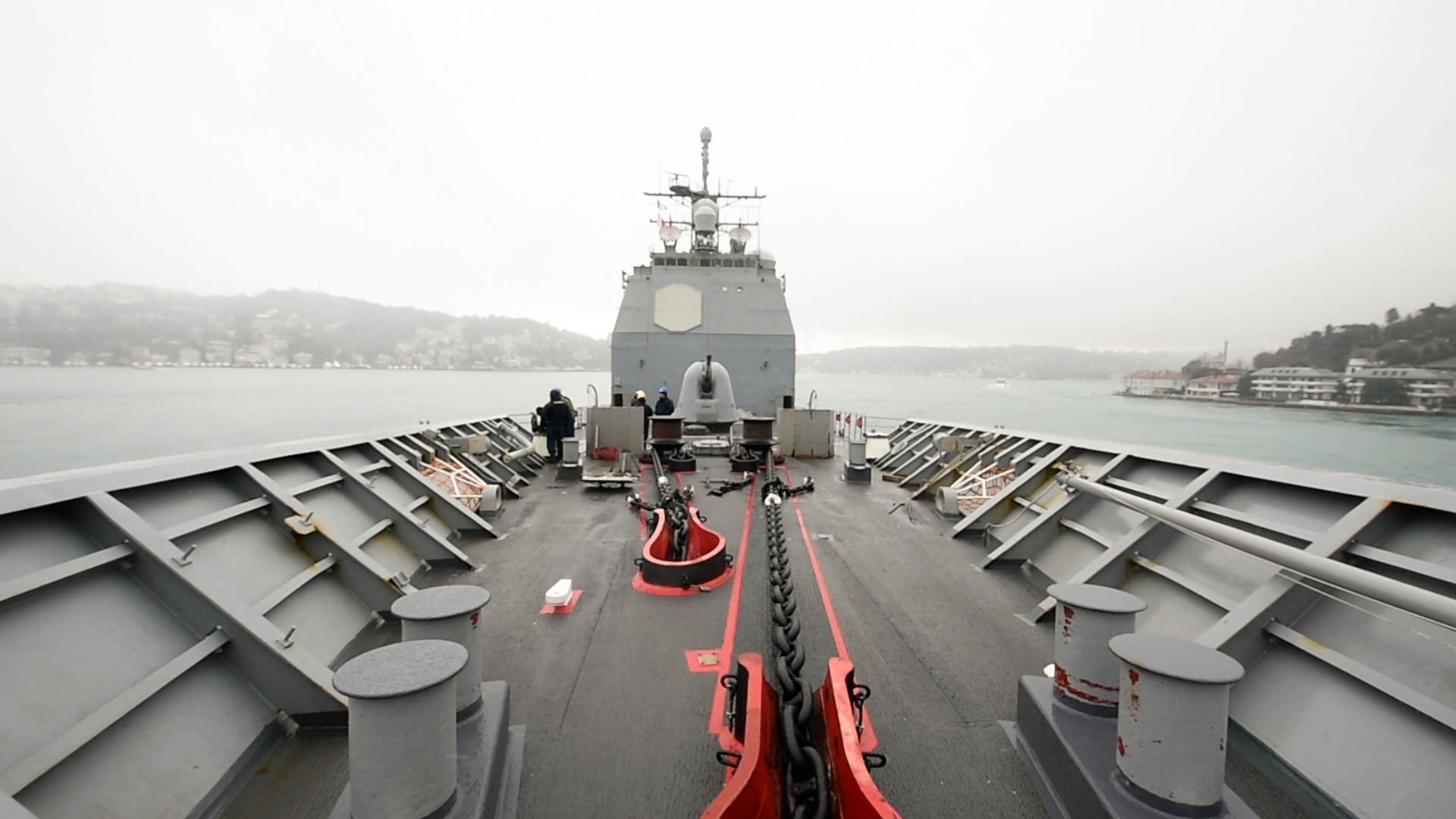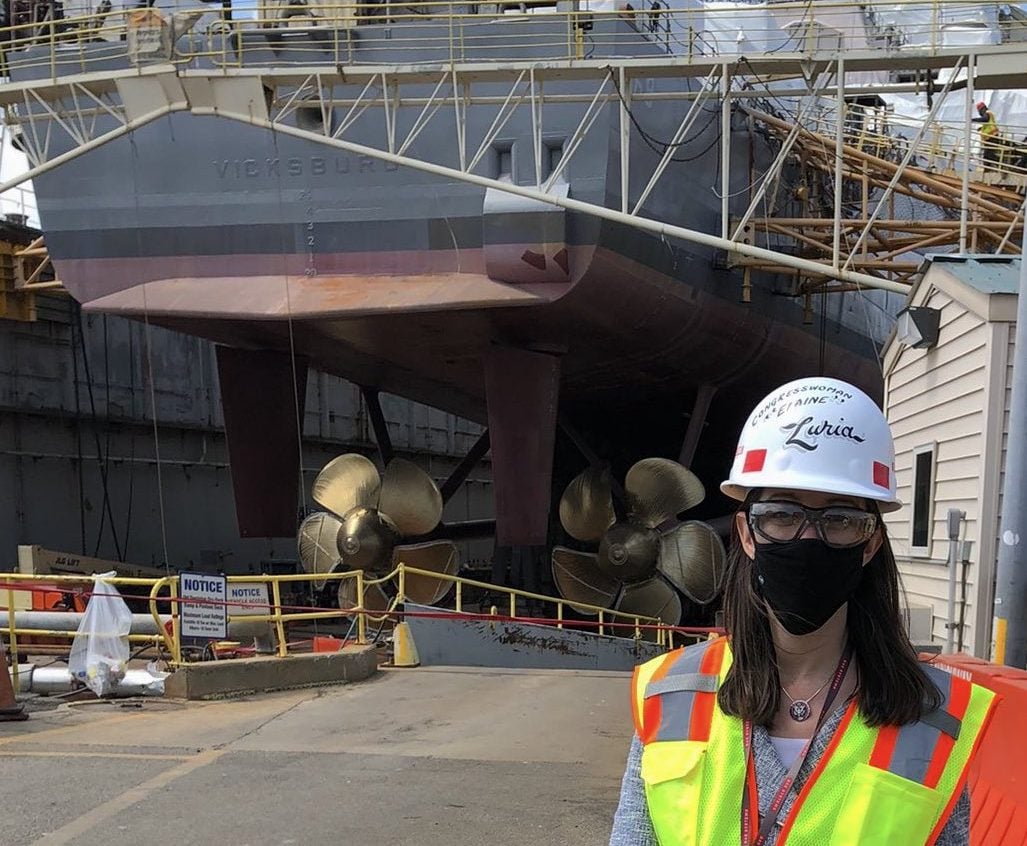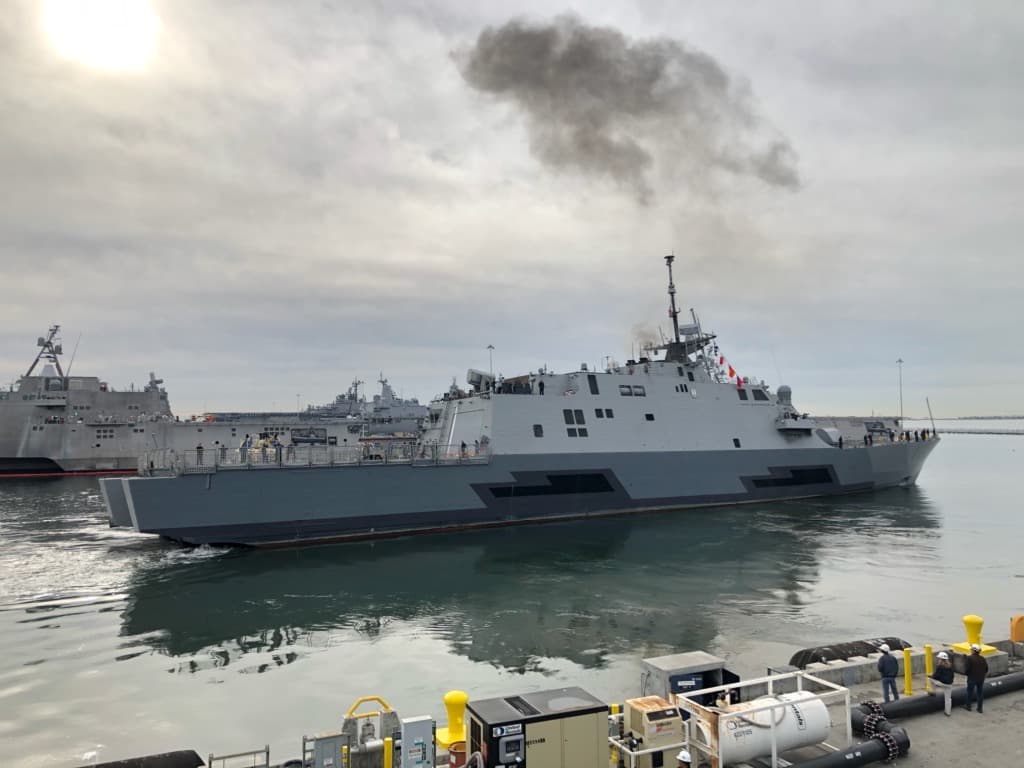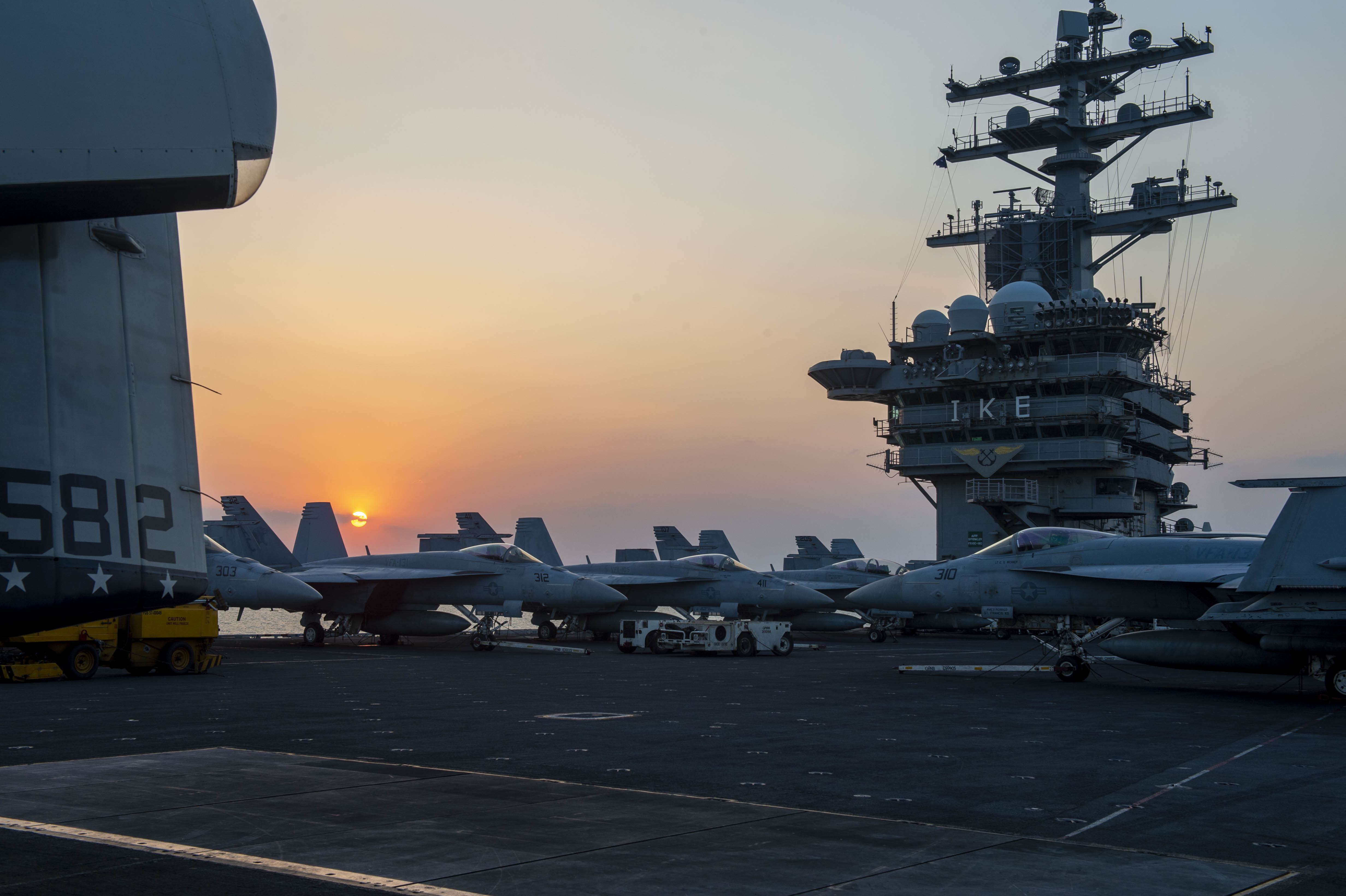
The vice-chair of the House Armed Services Committee does not support the Navy’s “divest to invest” strategy of ridding the fleet of aging and expensive-to-maintain ships and systems to free up money for the development of unmanned platforms and other new technology, saying the sea service needs to focus on getting ready for a near-term battle instead of looking too far out into the future.
When the Navy began planning its future force design in 2019 and into 2020, it was looking at a 2030 timeframe – what the threat from China and other actors might be, and what kind of a fleet would be needed to deter a fight or win if one broke out. The Pentagon stepped in and forced the service to change gears, creating a Battle Force 2045 plan that aimed to look at where China might go in a longer timeline and ensure the Navy could get well ahead of the threat.
Rep. Elaine Luria (D-Va.), who sits on the seapower and projection forces subcommittee, told USNI News that the Navy instead needs to focus on what threat China could pose this decade.
“Of course it’s important to look to 2045 and look out in the future, but I don’t think that the Navy’s doing enough today to emphasize – we need Battle Force 2025. You had Adm. [Phil] Davidson, outgoing INDOPACOM Commander, Adm. [John] Aquilino, incoming – both testified to the Senate recently that it’s not beyond the realm of the possible that the Chinese could take action and invade Taiwan in the next six years. And so, although we should be looking out into the future, we need to make sure we have the navy we need today,” she said in an interview.

While she said she supports a modest research and development budget for future technologies like unmanned platforms, she said the focus today needs to be readiness and fleet size – which, in a short timeframe, means keeping the ships the Navy has today in fighting condition, since new ship construction is such a slow process.
“China is a threat, and we need to take it seriously. And I can envision the day when we wake up and people are looking around saying, where’s the aircraft carrier, where are our ships and aircraft, because China has potentially just invaded Taiwan or taken other aggressive action against us or our allies – and it would be too late at that point, these are investments we need to make today,” she said of current readiness.
The Navy last year, in its Fiscal Year 2021 budget request, started down the path of a divest-to-invest strategy, asking to decommission the first four Littoral Combat Ships, four Ticonderoga-class cruisers and three Whidbey Island dock landing ships early. Though the FY 2022 budget request is still in the works, it is widely expected that the Navy will ask to decommission a larger number of cruisers early, given the challenges they’ve had in keeping the aging ships in operable condition and the challenges associated with an ongoing cruiser modernization plan.
Asked about the possibility of the Navy continuing to ask to divest of current ships to make room in the budget for new systems – unmanned, hypersonic weapons, directed energy weapons, high-end networks and more needed for the 2045 fight against China – Luria said she wouldn’t support it.
“I’m not buying it because we need to look at what’s Battle Force 2025, we need to look at what we have today and how we can use it and how we can use it most efficiently. The idea of divesting of current platforms that still have usable service life in order to invest in something that we might develop the technology for in the future – paired with our poor track record on [developing new] platforms – just makes absolutely no sense to me,” she said.
“I agree with research and development into new technologies, I agree with a modest investment into developing capabilities for unmanned surface vessels; however, while that remains a technology that’s not mature, I do not agree with divesting of resources and assets that we have today that are desperately needed in order to deal with the issue we have with China, with Russia, and just around the world.”
On the cruisers specifically, despite the challenges with the cruiser modernization program, she said she toured two of the in-repair cruisers recently and still believes in finishing the work and keeping them in the fleet.
“I’ll continue to say what I have: it’s a ship that we have, and the cost of modernizing and upgrading it for extending its service life 10 or so years is significantly lower than building a new ship,” said Luria, the former executive officer of cruiser USS Anzio (CG-68), adding that “the amount of time it takes to build a new ship, we just can’t decommission 10 cruisers faster than we can build replacements.”
“We have a real and proximate threat from China in the Western Pacific, South China Sea, East China Sea. We need to be present, and we need the capabilities that a cruiser brings, including its VLS cells. So the idea that the Navy’s longer-range plan in this Battle Force 2045 is to replace cruisers – who have two full [Vertical Launching System] launchers, over 120 cells – with a fleet of these Large Unmanned Surface Vessels with 16 VLS cells, a technology that’s not mature,” is not one she can support.

She said her “jaw dropped” when the Navy asked to divest of the four LCSs last year, and she continues to support keeping those ships in the fleet even if mission module development lags behind schedule, in part because of testimony from U.S. Southern Command commander Adm. Craig Faller. He told HASC earlier this year that USS Freedom (LCS-1) and USS Gabrielle Giffords (LCS-10) were able to do a lot for SOUTHCOM in terms of working with partners, providing naval presence and conducting anti-trafficking missions.
“A platform is a platform, and a platform can perform a mission,” Luria said, even if the mission isn’t a high-end one – and she said if the decision comes down to having more lower-end ships today or investing in new technology that won’t be fielded for years, she would pick keeping the ships today.
“I just feel like this divesting is divesting of capability, leaving gaps where combatant commanders have needs, and we just need to use what we have where we can use it,” she said.
The Navy has argued it needs to divest of certain items – older ships that are costing too much to maintain, ships like the first four LCSs that don’t have the right upgrades to where the Navy would want to actually deploy them to a contested waterway, or systems that are outdated and don’t reflect how the Navy would want to fight in the future – because freeing up money in the budget is the only way to create room for investments in new gear amid expected flat budgets.
The Marine Corps has taken a similar approach in its Force Design 2030 effort, though its divestments have involved shedding entire mission sets such as tanks and law enforcement, as well as reducing the numbers of some types of aircraft that would still deploy in traditional Marine Expeditionary Unit deployments but wouldn’t be used in the emerging Expeditionary Advanced Base Operations model with small, dispersed units.
The Navy, on the other hand, arguably isn’t giving up any missions wholesale but rather is shedding capacity at a time when some like Luria aren’t comfortable losing ship hulls and missile cells if a fight with China may even potentially be looming.
Broadly, Luria said she worries that the Navy is imposing restrictions on itself by asking for a flat budget it thinks it can get, instead of asking for the budget it needs and then working hard to make a convincing case for more money.
“I feel like in every opportunity they go in with these constraints they put on themselves, and the very first thing they say is, well we assume we’re only going to get this much so let me tell you what I can buy with what I think you’re going to give me, rather than something more in line with what John Lehman did in the 1984 National Maritime Strategy where it was like, this is the Navy that the nation needs and this is why: we need a 600-ship Navy, here’s why we need it, we need to defeat the Soviet Union, we need this many ships in the North Atlantic, this many in the Mediterranean, this many in the Pacific, and it’s an investment that we have to make to defend ourselves, deter the Soviet Union. And the entire country bought it and understood it and we literally built almost 600 ships for that effort,” she said.
“And I just feel like the communication from the Navy, it’s not clear and they’re not acting on the sense of urgency that’s necessary with regards to China and their current ongoing actions in the Pacific.”
Luria called for 3- to 5-percent real growth in defense budgets, with a higher percentage going to the Navy and the Air Force and less going to the Army, in acknowledgment that a fight with China would rely more heavily on maritime and air forces.

Several sources told USNI News that the Pentagon’s Cost Assessment and Program Evaluation (CAPE) office is likely to have an outsized role in developing this year’s Navy budget request, in part due to there not being any permanent civilian leadership at the helm of the Navy still after the Biden administration took over – so it appears unlikely that the Navy would make a bold request instead of sticking to the anticipated one-third allotment of a flat defense budget.
Luria told USNI News that she sees several troubling trends on Navy readiness, especially as it relates to the aircraft carrier fleet. First, she said, she worries that the Navy had been able to shed the requirement to have continuous carrier presence in the Middle East but has since gotten sucked back into that mission due to what she called malign activities by Iran.
“Here we are, continuously draining our readiness and our ability to put presence in the Western Pacific in response to China by continuously having a carrier penned down in the Middle East,” she said.
Second, she worried the Navy didn’t have enough capacity to maintain a fleet of 11 nuclear-powered carriers at just two public shipyards. She said the Navy used to have a few conventionally powered carriers and performed maintenance on USS Enterprise (CVN-65) at Newport News Shipbuilding, but since the fleet transformed to an all-nuclear fleet that’s solely maintained at Norfolk Naval Shipyard and Puget Sound Naval Shipyard and Intermediate Maintenance Facility, availabilities have run longer and the backups have affected fleet operations.
Luria said she spoke recently with two Navy leaders overseeing ship readiness and maintenance and can see where data shows the service is on the right track when it comes to getting more maintenance done on time and on budget. But she said the Navy needs to convince industry to invest in more capacity to do private yard repairs, and proposals like decommissioning half the cruiser fleet send the wrong signals to industry.
“A lot of the challenges that I hear across the waterfront here in Hampton Roads … is that the lack of level-loading of the port, the ability of the yards that conduct this maintenance to plan long-term into the future, prevents them from making those investments to grow their workforce and to invest and increase capacity,” she said.
“These knee-jerk things like decommissioning cruisers kind of just puts that workforce in a tailspin again, and we could be looking at layoffs of hundreds of people across the waterfront in Hampton Roads because of those sudden changes.”
She summed up her hopes for the Navy simply: “A three-pronged thought I have on it is, we need to build more ships and we need to build them as quickly as possible; we need to both maintain the ships we have and deploy them as efficiently as possible; … and then stop decommissioning ships faster than we can build them.”





